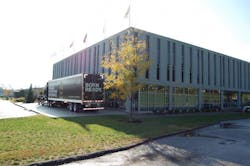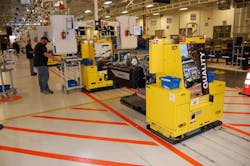Mack adds drive axles, carrier housings to Hagerstown plant production
HAGERSTOWN, MD. The new Mack Trucks axle line at the Volvo/Mack factory here in Western Maryland represents a two year, $30 million investment by the OEM aimed at furthering efforts to offer its customers a completely integrated powertrain package – one aimed at making its dealerships more “one-stop-shops” for complete vehicle support, boosting fuel economy, plus making it easier for Mack to comply with greenhouse gas emission (GHG) rules.
“Complete powertrain integration is extremely important today,” stressed Stephen Roy, president of Mack Trucks North America, at an event here officially inaugurating drive axle production and carrier housing machining at the 1.5 million sq. ft. facility.“Customers are looking for a competitive advantage with their trucks – demanding greater fuel economy and better vehicle performance – while they must also be in compliance with EPA [Environmental Protection Agency] greenhouse gas rules,” he said.
Stu Russoli, highway/powertrain marketing manager for Mack, told Fleet Owner that “any time you save fuel, you reduce the carbon footprint of a truck – and that plays right into meeting the GHG rules.”
He added that building drive axles and machining carrier housings at the Hagerstown plant (seen above) also gives the OEM a greater ability to “tweak” the entire powertrain system to potentially generate further fuel savings down the road.
There’s also the opportunity to make drive axles “smarter” via in-house production, adding sensors to them not only to create more direct electronic linkage to the engine and transmission for boosting fuel savings but also possibly enhancing prognostic maintenance care as well.
“We’ve already got ECUs [electronic control modules] all over the truck, and plenty of sensors, too,” Russoli explained. “It’s really a question of just how ‘smart’ the drive axles might need to be.”
Adding drive axle production to the Hagerstown facility – which Mack said represents 100,000 sq. ft. of additional factory space and 100 new jobs – also improves lead times for customers, Roy noted, as placing engine, transmission and axle assembly all under “one roof” allows the OEM to optimize its supply chain.
Mack officially began producing drive axles at the Hagerstown factory back in July and is currently up to 128 units per shift. The company added that the two year, $30 million plant upgrade included improvements to the facility’s engine assembly process and centralization of aftermarket core warehousing operations at Hagerstown, too.Currently, only 11 and 13 liter Volvo D11 and D13 as well as Mack MP7 and MP8 engines (seen at right) are built at Hagerstown.
The big 16-liter Volvo D16 and Mack MP10 units, however, continue to be built entirely in Sweden and shipped to the U.S., though they undergo a battery of tests at the Hagerstown plant before being shipped to the Volvo New River Valley factory in Dublin, VA, and the Mack Macungie, PA, plant, respectively.
Hagerstown is also where the Volvo I-shift automated manual transmission (AMT) is built, along with the Mack mDrive and mDrive HD AMT units, plus the Mack T-300 manual gearbox.
Roy also noted that its drive axles used to be built by the American Axle company, but that firm wanted to focus more on the automotive sector so the decision to bring Mack axle production in house “came at a good time for both of us.”
He added that Meritor and Link Manufacturing continue to supply Mack with the axles for its Load Logic 6x2 package unveiled back in March and the Mid America Trucking Show and that there are no plans to change that arrangement.
About the Author
Sean Kilcarr
Editor in Chief
Sean Kilcarr is a former longtime FleetOwner senior editor who wrote for the publication from 2000 to 2018. He served as editor-in-chief from 2017 to 2018.


